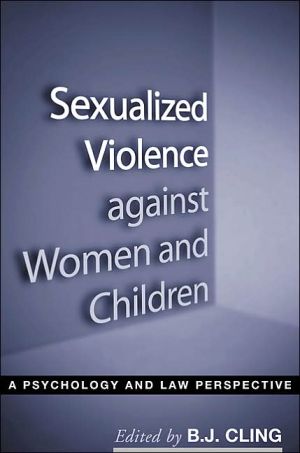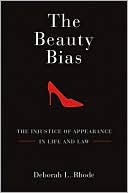Sexualized Violence Against Women and Children: A Psychology and Law Perspective
The first book to interweave clinical and legal perspectives on such recently formulated diagnoses as rape trauma syndrome and battered woman syndrome, this up-to-date resource helps mental health clinicians better understand their role in criminal or civil proceedings related to sexualized violence against women and children. Foundational knowledge is provided on the nature, prevalence, and psychological consequences of a variety of crimes, including rape, spousal abuse, stalking, sexual...
Search in google:
The first book to interweave clinical and legal perspectives on such recently formulated diagnoses as rape trauma syndrome and battered woman syndrome, this up-to-date resource helps mental health clinicians better understand their role in criminal or civil proceedings related to sexualized violence against women and children. Foundational knowledge is provided on the nature, prevalence, and psychological consequences of a variety of crimes, including rape, spousal abuse, stalking, sexual harassment, and child sexual abuse. The ways victims and perpetrators are dealt with in the legal system are critically examined, and important recent reforms discussed. Presenting guidelines and findings that will improve forensic assessment, this is a vital sourcebook for those called on to serve as expert witnesses and an invaluable student text.
Sexualized Violence against Women and Children\ A Psychology and Law Perspective \ \ The Guilford Press\ Copyright © 2004 The Guilford Press\ All right reserved.\ ISBN: 1-59385-061-1 \ \ \ Chapter One\ Introduction \ B. J. CLING\ This book is about wrongs-often sexual wrongs-perpetrated against women and children. Although all of these have been written about separately at length, this is the first time they have been gathered into one volume that examines them as new psychological syndromes, and as legal causes of action that protect women and children against sexualized violence. The recent "discovery" or identification of these psychological harms and these recently enacted (or actively prosecuted) laws are directly linked to the recent wave of feminism. Because it has become possible for women in significant numbers to train as doctors and lawyers-in part by making it illegal to refuse to admit them to professional schools and then illegal to deny them professional jobs-women have moved into the professions in droves. The new recognition of age-old psychological problems that result from various traumas, in particular sexual traumas, and the new outrage against perpetrators of these traumas, are directly related to the presence of women in roles that aid victims of these traumas. As professional women have noticed and objected to these wrongs, professional men have focused more interest and energy on these problems as well.Social change has been brought about by focusing on such evils as rape, spousal abuse, and child sexual abuse and by heightening awareness of their presence and their devastating effects. Part of that social change is embodied in the emergence of these new psychological syndromes and laws. And, in turn, their recognition has continued the process of social change.\ However, underlying the investigation of this new "outbreak" of psychological syndromes and protective laws is the assumption that the fields of psychology and law intersect and interact. This chapter now examines that assumption.\ In my own case, I entered the field of law after training first as a clinical psychologist, then as a forensic psychologist. One of my first challenges as a forensic psychology trainee (or postdoctoral fellow, as I was then) was to look at the two fields and try to understand their differences, particularly the mindset of lawyers and the legal profession (judges included), so that I could speak their language and make my points more effectively in their venue. I quickly came to see that my training in psychology was radically different from legal thinking, and I could see why many psychologists and psychiatrists had difficulty giving credible testimony in court.\ Psychology, and all the social sciences, are fundamentally empirical. Obviously, experimental psychology, for example, is more empirically based than clinical work. But even clinical work is based on observation of patients, and on a view that the practitioner looks to see what is out there in the world to know what to do. This contrasts sharply with the field of law. In law, what follows logically is king. Thus, although the law may make some empirical assumptions (e.g., that people reasonably expect not to be searched in their homes), it rarely if ever looks at the empirical data that might back this up (or refute it). The law is also indifferent to probabilistic notions (e.g., that something is likely to have happened as opposed to definitely having happened), and looks for possibility, not probability. In addition to its assumption that people are logical in their thinking (which is empirically questionable), the law assumes that people are emotionally neutral and have no biases. Thus, except for the voir dire examination of a jury (where possible bias is explored and obviously biased jurors eliminated) attitudinal bias is rarely addressed. Yet empirical research clearly shows general prejudice in the population on many issues. These prejudices are probably shared by the lawmakers who make the laws as well. However, if psychological realities were acknowledged instead of ignored, laws could be devised that counteract prejudice, instead of wrongly assuming it does not exist.\ Another interesting difference between psychology and law is that there is a high degree of (perhaps healthy) skepticism among lawyers that is not characteristic of mental health professionals. Clinical psychologists, for example, are used to believing their patients, who have no obvious motive to lie to their therapists. However, in most arenas of law, there is a win-lose situation (i.e., if one side wins, the other loses). Law is fundamentally adversarial. In fact, our justice system is founded on the premise that, by having two opposing sides argue against each other, the truth will out. Thus, one side always has a motivation to shade things to its advantage. This is also true in most areas of forensic psychology, where people being evaluated have a lot to gain or lose by the outcome of the forensic evaluation. Thus, a forensic psychologist must also be skeptical and be prepared to deal with the issue of malingering.\ Interestingly, the mode of presentation in psychology and in law are different as well. Generally, in science, you present the history of the area you are investigating, describe what you did, and then present the results and conclusions. In law, you present the conclusion first, then you go back and prove how you came to it, and then you repeat it at the end. Judges and lawyers are not used to having general considerations presented first and then narrowed down until finally a conclusion is reached. In fact, they tend to have the impression that the reasoning is fuzzy and unclear if the conclusion is not immediately in sight. Thus, mental health testimony may be discounted if it is presented in the wrong format.\ Another problem created by the overlap, and yet also the differences, between psychology and law is that when laws are made or used in the courtroom, they often do not take into consideration the psychological realities of the areas with which they are dealing. For example, empirical research shows us that child victims of sexual abuse have difficulty reporting their abuse. As a result, appropriate questioning has to take place in a context that helps the victim tell the truth. Only recently have such new legal adaptations as closed-circuit TV questioning of child victims in court taken place, so that a young child does not have to be in the same room as the terrifying defendant who abused him or her (and thereby be frightened into silence).\ Another example is the considerable difficulty faced by those trying to help battered women who have struck back and killed their abusers. First, the notion of self-defense, as it has usually been used in law, assumes two people fighting each other, often people who are not very involved with each other and who have little history together. In the case of spousal abuse, for example, a long history of a man physically punching and kicking his wife provides a different context for hearing threats such as "When I come home I'm going to kill you." Thus, although from the battered woman's point of view it is self-defense when she shoots the battering spouse when he comes home, from a traditional prosecutor's point of view it is not, as the spouse did not threaten her just minutes before she shot him. Thus, the wife is the aggressor. And such women are regularly charged with murder, even though their husbands had repeatedly put them in the hospital with extreme violence. The psychological context within which the threat occurs provides an explanation for this normal reaction to an atmosphere of violence. In an effort to bring psychological knowledge into the legal arena, feminist lawyers have attempted to introduce expert testimony on battered woman syndrome and the effects of battering to help a jury understand why, from the battered woman's perspective, her actions were self-defense.\ Another good example of an area in which the fields of psychology and law should successfully meet, but do not completely, is sexual harassment. Sexual harassment in the workplace is now illegal, in large measure due to the efforts of Catherine MacKinnon in her seminal book Sexual Harassment of Working Women, in which she outlines the harm to women of being harassed at work. However, it is now a near requirement that credible cases of sexual harassment be filed quickly by a woman who has been harassed. A delay in filing against an employer is usually seen as a sign that the woman was not really harmed, or that the harassment never took place. Yet, if lawmakers and judges looked at the psychological research on typical victim reaction, they would find that it is typical, when sexually assaulted or harassed, to feel traumatized. Victims of trauma (or posttraumatic stress disorder) try to minimize their emotional reactions in an effort to contain the flood of out-ofcontrol feelings they feel. As a result they often are not psychologically able to report these wrongs right away. They need to detach emotionally from the stress of the event(s). Then they are ready to take legal action. In such a case, the normal psychological reaction to a true event (and one which is illegal) is to wait a bit. The law should understand this and take it into consideration when thinking about how to maximize the reporting and prosecuting of these crimes.\ It is the view of this book that it is important to have knowledge of both psychology and law in order to be effective in the area of forensic psychology. As a psychologist, it is essential to understand what the law is, how it operates, and how those practicing it think in order to influence proceedings in a court of law. And, as a lawyer, it is helpful to understand the psychological context in which crimes and various mental states occur, in order to know how to use expert testimony effectively and how to craft laws that address pertinent issues. Too often, laws are narrowly drawn, ignoring the true nature of an offense and not looking to empirical evidence that tells you what is really occurring in the mind of a perpetrator or the damage in terms of the psychological effect on a victim. It is only by having a good understanding of both disciplines that their overlap can be productive in protecting our society from harm. This book attempts to foster that understanding.\ (Continues...)\ \ \ \ \ Excerpted from Sexualized Violence against Women and Children Copyright © 2004 by The Guilford Press. Excerpted by permission.\ All rights reserved. No part of this excerpt may be reproduced or reprinted without permission in writing from the publisher.\ Excerpts are provided by Dial-A-Book Inc. solely for the personal use of visitors to this web site. \ \
1Introduction1Pt. ISexualized violence against women72Rape and rape trauma syndrome133Battered woman syndrome : clinical features, evaluation, and expert testimony414Battered women who strike back : using expert testimony on battering and its effects in homicide trials715Stalking986Sexual harassment in the workplace : a legal and psychological framework115Pt. IISexualized violence against children1497Child sexual abuse1518Memories of childhood abuse : recovered, discovered, and otherwise188Pt. IIIPerpetrators of sexualized violence and other harms against women and children2139Management and treatment of the adult sexual offender21710Megan's law : new protections against sex abuse24511Maternal violence : the social psychology of mothers who kill261Epilogue292
\ From the Publisher"In Sexualized Violence against Women and Children, Cling has brought together an 'A-list' of scholars and practitioners to offer fresh insights into a social problem of enduring significance. Mental health professionals, lawyers, and advocates will all find much of value in these well-crafted chapters."--John Monahan, PhD, University of Virginia School of Law\ "This volume is a welcome update in a field growing by leaps and bounds. The authors provide the latest psychological theories together with legal imperatives to help clinicians and lawyers in the courtroom. Everyone involved in treating clients who have been physically or sexually abused, or in working with them when litigation occurs, should have a copy of this book on their desk. You'll find what you need in these pages."--Lenore Walker, EdD, Forensic Psychology Concentration, Nova Southeastern University\ "An excellent reference joining theoretical constructs within psychology and law on topics related to sexual harassment, battered women, and maternal violence, to name a few. Whether or not one subscribes to the various theoretical perspectives described, this book brings together a group of papers with supporting literature and helpful pointers that are wholly relevant and useful in a variety of clinical and legal contexts."--Debra A. Pinals, MD, Department of Psychiatry, University of Massachusetts Medical School\ "Outstanding. Social workers will find the legal content on sexualized violence current, accessible, and comprehensive. The editor and contributors successfully integrate clinical and legal perspectives on significant topics, including rape, sexual abuse, and sexual harassment. This knowledge base enables clinicians to work more effectively with clients experiencing sexualized violence, to prepare for involvement in cases as a witness or expert, and to advocate for reforms to the law. Should be required reading for all social workers working with clients who have experienced sexual violence."--Robert G. Madden, LCSW, JD, Social Work Program, St. Joseph College\ \ \ \ \ \ \ Cognitive Behavioral Therapy Book Reviews"A remarkable text, with chapters that are both authoritatively written and thought provoking....An excellent text. It is hugely informative, gathering together much of what is new in the field. Each chapter is authoritatively and clearly written. This book is likely to appeal to academics, clinicians and legal professionals alike....Accessible, informative, and of enormous appeal."--Cognitive Behavioral Therapy Book Reviews\ \ \ Psychiatric Services"I would recommend this book to clinicians and attorneys who work with sexually abused women and children in the courtroom. It will be of particular interest to individuals who are interested in the sociologic and cultural underpinnings of sexualized violence against women and children."--Psychiatric Services\ \








